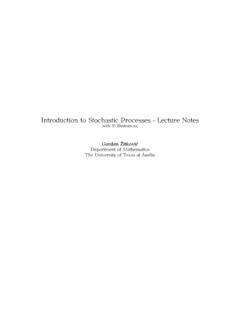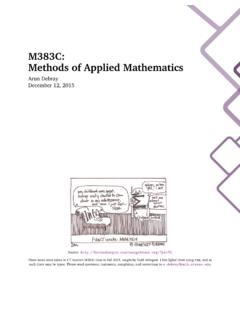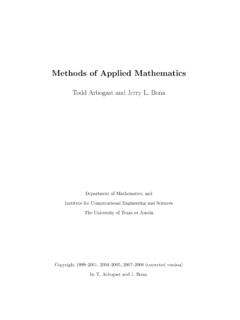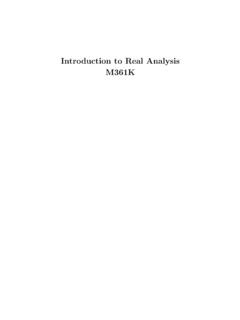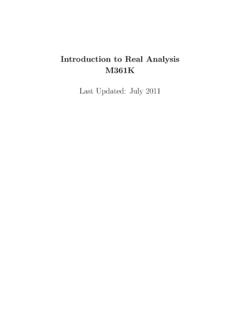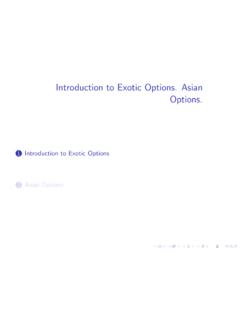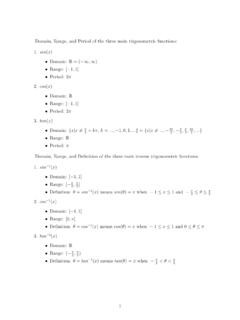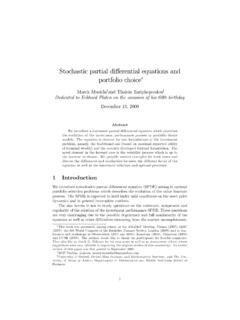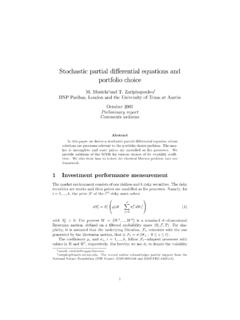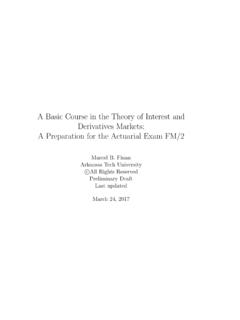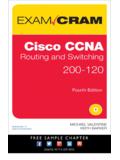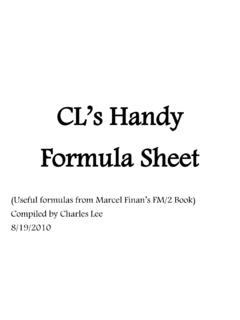Transcription of EXAM FM SAMPLE QUESTIONS - web.ma.utexas.edu
1 1 SOCIETY OF ACTUARIES EXAM FM FINANCIAL MATHEMATICS EXAM FM SAMPLE QUESTIONS Financial Economics June 2014 changes QUESTIONS 1-30 are from the prior version of this document. They have been edited to conform more closely to current question writing style, but are unchanged in content. question 31 is the former question 58 from the interest theory question set. QUESTIONS 32-34 are new. January 2015 changes QUESTIONS 35-46 are new. May 2015 changes question 32 was modified (and re-modified in June) QUESTIONS 47-62 are new. Some of the QUESTIONS in this study note are taken from past examinations.
2 These QUESTIONS are representative of the types of QUESTIONS that might be asked of candidates sitting for the Financial Mathematics (FM) Exam. These QUESTIONS are intended to represent the depth of understanding required of candidates. The distribution of QUESTIONS by topic is not intended to represent the distribution of QUESTIONS on future exams . Copyright 2015 by the Society of Actuaries. FM-09-15 PRINTED IN 2 1. Determine which statement about zero-cost purchased collars is FALSE (A) A zero-width, zero-cost collar can be created by setting both the put and call strike prices at the forward price.
3 (B) There are an infinite number of zero-cost collars. (C) The put option can be at-the-money. (D) The call option can be at-the-money. (E) The strike price on the put option must be at or below the forward price. 2. You are given the following: The current price to buy one share of XYZ stock is 500. The stock does not pay dividends. The annual risk-free interest rate, compounded continuously, is 6%. A European call option on one share of XYZ stock with a strike price of K that expires in one year costs A European put option on one share of XYZ stock with a strike price of K that expires in one year costs Using put-call parity, calculate the strike price, K.
4 (A) 449 (B) 452 (C) 480 (D) 559 (E) 582 3 3. Happy Jalapenos, LLC has an exclusive contract to supply jalapeno peppers to the organizers of the annual jalapeno eating contest. The contract states that the contest organizers will take delivery of 10,000 jalapenos in one year at the market price. It will cost Happy Jalapenos 1,000 to provide 10,000 jalapenos and today s market price is for one jalapeno. The continuously compounded annual risk-free interest rate is 6%. Happy Jalapenos has decided to hedge as follows: Buy 10,000 put options for and sell 10,000 call options for Both options are one-year European.
5 Happy Jalapenos believes the market price in one year will be somewhere between and per jalapeno. Determine which of the following intervals represents the range of possible profit one year from now for Happy Jalapenos. (A) 200 to 100 (B) 110 to 190 (C) 100 to 200 (D) 190 to 390 (E) 200 to 400 4 4. Zero-coupon risk-free bonds are available with the following maturities and annual effective yield rates: Maturity (years) Yield Rate 1 2 3 Susan needs to buy corn for producing ethanol. She wants to purchase 10,000 bushels one year from now, 15,000 bushels two years from now, and 20,000 bushels three years from now.
6 The current forward prices, per bushel, are , , and for one, two, and three years respectively. Susan wants to enter into a commodity swap to lock in these prices. Determine which of the following sequences of payments at times one, two, and three will NOT be acceptable to Susan and to the corn supplier. (A) 38,900; 61,650; 83,200 (B) 39,083; 61,650; 82,039 (C) 40,777; 61,166; 81,554 (D) 41,892; 62,340; 78,997 (E) 60,184; 60,184; 60,184 5 5. The PS index has the following characteristics: One share of the PS index currently sells for 1,000.
7 The PS index does not pay dividends. Sam wants to lock in the ability to buy this index in one year for a price of 1,025. He can do this by buying or selling European put and call options with a strike price of 1,025. The annual effective risk-free interest rate is 5%. Determine which of the following gives the hedging strategy that will achieve Sam s objective and also gives the cost today of establishing this position. (A) Buy the put and sell the call, receive (B) Buy the put and sell the call, spend (C) Buy the put and sell the call, no cost (D) Buy the call and sell the put, receive (E) Buy the call and sell the put, spend 6.
8 The following relates to one share of XYZ stock: The current price is 100. The forward price for delivery in one year is 105. P is the expected price in one year Determine which of the following statements about P is TRUE. (A) P < 100 (B) P = 100 (C) 100 < P < 105 (D) P = 105 (E) P > 105 6 7. A non-dividend paying stock currently sells for 100. One year from now the stock sells for 110. The annual risk-free rate, compounded continuously, is 6%. A trader purchases the stock in the following manner: The trader pays 100 today The trader takes possession of the stock in one year Determine which of the following describes this arrangement.
9 (A) Outright purchase (B) Fully leveraged purchase (C) Prepaid forward contract (D) Forward contract (E) This arrangement is not possible due to arbitrage opportunities 8. Joe believes that the volatility of a stock is higher than indicated by market prices for options on that stock. He wants to speculate on that belief by buying or selling at-the-money options. Determine which of the following strategies would achieve Joe s goal. (A) Buy a strangle (B) Buy a straddle (C) Sell a straddle (D) Buy a butterfly spread (E) Sell a butterfly spread 7 9.
10 Stock ABC has the following characteristics: The current price to buy one share is 100. The stock does not pay dividends. European options on one share expiring in one year have the following prices: Strike Price Call option price Put option price 90 100 110 A butterfly spread on this stock has the following profit diagram. The annual risk-free interest rate compounded continuously is 5%. Determine which of the following will NOT produce this profit diagram. (A) Buy a 90 put, buy a 110 put, sell two 100 puts (B) Buy a 90 call, buy a 110 call, sell two 100 calls (C) Buy a 90 put, sell a 100 put, sell a 100 call, buy a 110 call (D) Buy one share of the stock, buy a 90 call, buy a 110 put, sell two 100 puts (E) Buy one share of the stock, buy a 90 put, buy a 110 call, sell two 100 calls.
